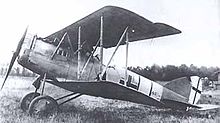| Some of this article's listed sources may not be reliable. Please help improve this article by looking for better, more reliable sources. Unreliable citations may be challenged and removed. (February 2022) (Learn how and when to remove this message) |
| Jagdstaffel 5 | |
|---|---|
 Jagdstaffel 5 flight line Jagdstaffel 5 flight line(1 September 1917) | |
| Active | 1916–1918 |
| Country | German Empire |
| Branch | Luftstreitkräfte |
| Type | Fighter squadron |
| Nickname(s) | "Greentails"; "Green-Tailed Devils" |
| Colors | Green tails with red piping; red nose; various personal fuselage insignia |
| Engagements | World War I |
| Website | http://www.jasta5.org |



History
Royal Prussian Jagdstaffel 5, commonly abbreviated to Jasta 5, was created on 21 January 1916, and mobilized on 21 August 1916, as one of the first fighter units of the Luftstreitkräfte, the air arm of the Imperial German Army during World War I. Many of the first pilots of the Jasta came out of KEK Avillers, itself an early attempt to organize and utilize fighter planes as winged weapons. Jasta 5 began its service career at Bechamp near Verdun, in support of 5 Armee. On 29 September 1916, it moved to the Somme to the 1 Armee area of operations. On 11 March 1917, Jasta 5 moved into Boistrancourt; it spent the next year operating from there, in support of the 2 Armee. In March 1918, the Jasta was joined by Jasta 46 thus forming the beginning of Jagdgruppe 2; the new JG was commanded by Flashar, along with his command of the Jasta. In July, command passed to Otto Schmidt; in August, it was joined in the JG by Jasta 34 and Jasta 37. With approximately 253 victories at war's end, Jasta 5 had the third-highest victory total of any squadron in the Luftstreitkräfte. Its casualties came to 19 pilots killed in action, 3 killed in flying accidents, 8 wounded in action, and 1 injured in an accident.
Commanding officers
- Hans Berr: 21 August 1916 – 2 January 1917
- Ludwig Dornheim: 2 January 1917 – 5 February 1917
- Hans Berr: 5 February 1917 – 6 April 1917 (KIA)
- Hans von Hünerbein: 7 April 1917 – 4 May 1917 (KIA)
- Kurt Schneider: 6 May 1917 – 5 June 1917 (WIA)
- Richard Flashar: 10 June 1917 – 31 December 1917
- Wilhelm Lehmann: 31 December 1917 – 14 January 1918
- Richard Flashar: 14 January 1918 – 12 May 1918
- Wilhelm Lehmann: 12 May 1918 – 26 June 1918 (KIA)
- Otto Schmidt: 3 July 1918 – 11 November 1918
Duty stations (airfields)
- Bechamp: 21 August 1916 – 25 September 1916
- Bellevue Ferme, Senon: 26 September 1916 – 29 September 1916
- Gonnelieu: 30 September 1916 – 10 March 1917
- Boistrancourt: 11 March 1917 – 25 March 1918
- Lieramont: 25 March 1918 – 23 April 1918
- Cappy-sur-Somme: 23 April 1918 – 27 July 1918
- Moislains: 27 July 1918 – 24 August 1918
- Nurlu: 24 August 1918 – 30 September 1918
- Neuville: 30 September 1918 – 7 October 1918
- Escarmain by Capelle: 7 October 1918 – 10 October 1918
- Villers-Sire-Nicole: 10 October 1918 – 11 November 1918
Personnel



There were several notable pilots and flying aces who served and scored with Jasta 5. Pilots earning Prussia's highest decoration for valor, the Pour le Mèrite ("Blue Max") who served at one time or another in Jasta 5 included (alphabetically):
- Paul Bäumer
- Hans Berr
- Heinrich Gontermann
- Hermann Göring
- Otto Könnecke
- Bruno Loerzer
- Fritz Rumey
- Werner Voss
Könnecke and Rumey were two of the three members of the "golden triumvirate", who were responsible for 40% of the total victories of the Jasta. The third member of the triumvirate not listed is Josef Mai, who although nominated and eligible for the award, was not officially awarded the Pour le Mèrite prior to the end of hostilities.
One member of Jasta 5 was rocket expert Rudolf Nebel.
Aircraft and operations

The squadron was originally equipped with Fokker Eindeckers. It progressed to use of Albatros D.IIs and Halberstadt D.IIs. In 1917, it was using Albatros D.IIIs and Albatros D.Vs. In 1918, it used both the Fokker D.VII and the Fokker Triplane. At one time, the Jasta was one of only three squadrons not belonging to a Jagdgeschwader (fighter wing) that was totally equipped with the Triplane. It also reputedly operated the Pfalz D.XII, which entered service in July 1918.
References
- ^ "Jasta 5". The Aerodrome. 2015. Retrieved 16 December 2015.
- ^ Merrill (2004), p. 1.
- ^ Franks, Bailey & Guest (1993), p. 31.
- "Pfalz D.XII". The Aerodrome. 2015. Retrieved 16 December 2015.
Bibliography
- Franks, Norman; Bailey, Frank W. & Guest, Russell F. (1993). Above The Lines: The Aces and Fighter Units of the German Air Service, Naval Air Service, and Flanders Marine Corps, 1914–1918. London, UK: Grub Street. ISBN 978-0-948817-73-1.
- Merrill, G. K. (2004). Jagdstaffel 5 (Volume 1). Berkhamsted, UK: Albatros Productions. ISBN 978-1-902207-67-4.
External links
- Bäumer, Paul. "Jagdstaffel 5 "Green Tails" in 1917". jasta5.org.
| Prussian | |
|---|---|
| Bavarian | |
| Saxon | |
| Württembergian | |
| Aviation in World War I | |
|---|---|
| People and aircraft | |
| Campaigns and battles | |
| Entente Powers air services |
|
| Central Powers air services | |